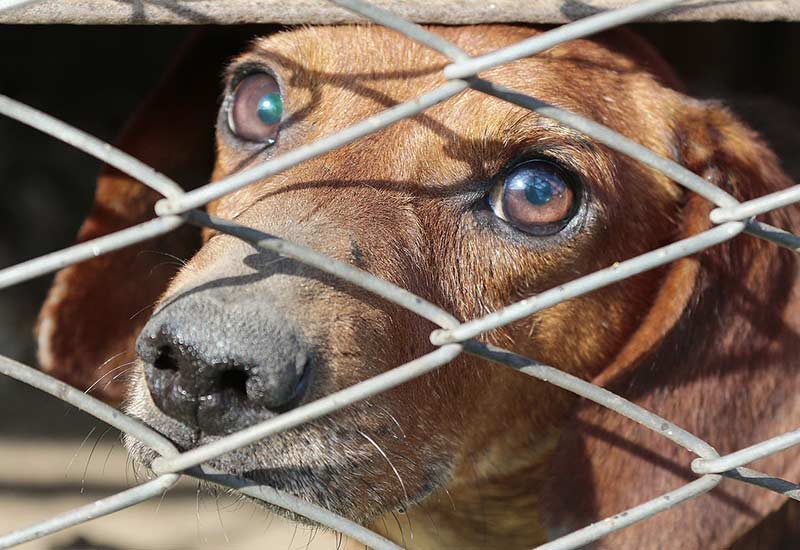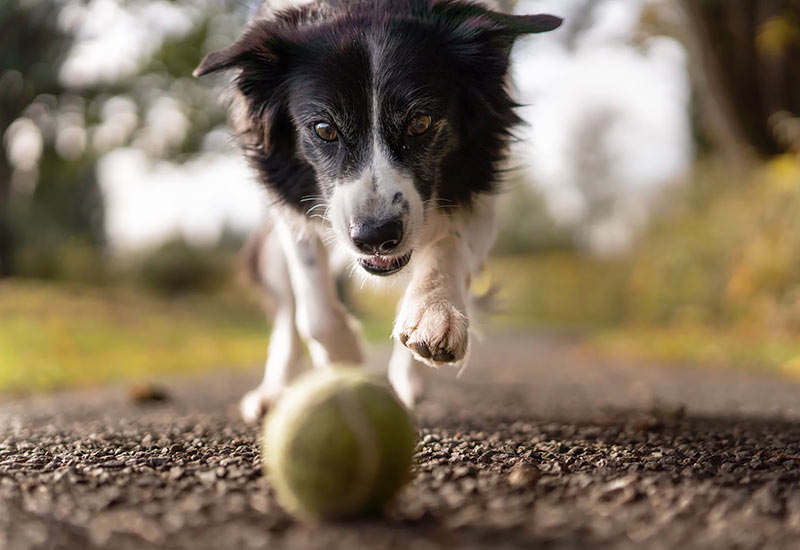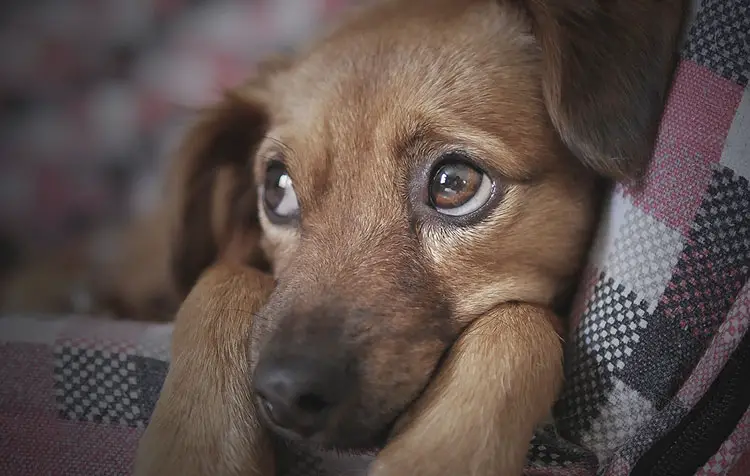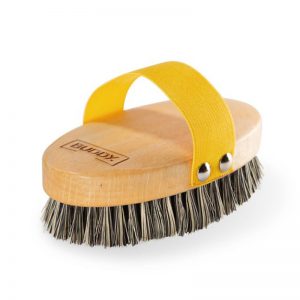You want to make your fearful dog feel safe? Then you've come to the right place! Dogs can feel insecure, nervous and anxious for a variety of reasons. Lack of socialization and bad past experiences are among the most common reasons. Accordingly, insecurity is primarily a trait that is often found in adopted dogs from animal protection and in general can be observed in "dogs with a past".
They have simply never learned how to deal with stressful situations and therefore usually react uncontrollably or even aggressively. As a dog owner or caretaker, it is therefore extremely important to understand how you can help your four-legged friends feel safer and more comfortable.
In this article, you will learn how to recognize insecure dogs and what tips you can use to boost their self-confidence. Let's go!
Here you can find a short overview in advance:
- Offer your dog enough rest and breathers
- Incorporate rituals and routines into the dog's daily routine
- Create a safe retreat
- Offer loving, appreciative and familiar interaction
- Be patient with your darling
- Avoid surprises or stressors
- Introduce your dog slowly to the situation
- Try to be a reliable leader
- Offer regular training and challenges
- Get help from a professional dog trainer
How can you tell if a dog is insecure or fearful?

A dog is a sensitive creature, which gives us Signals about his sensations sends. As a dog owner, it is important to interpret these correctly, because only then can we help dogs properly and ensure that they feel comfortable.
Some dogs are really deeply relaxed in any situation and are not intimidated by anything. But as with humans, there are also furry noses, who cannot handle every situation with confidence and are rather nervous in character.
The following signs may indicate that a dog is feeling unsafe right now:
- Flat ears: If a dog lays its ears flat back against its head, this may be a sign that it feels threatened and not safe.
- Avoidant behavior: A dog that feels insecure may try to move away and hide from the trigger of its insecurity.
- Body language: Insecure quadrupeds often try to make themselves smaller by tucking their tail between their legs and lowering their head. They may even become completely rigid and duck away.
- Aggressive behavior: In some cases, a dog that is insecure may also show aggressive behavior. These include, for example, growling and snapping - or jittery behavior and loud barking.
- FearA dog with low self-confidence often appears fearful. This can be recognized, for example, by the fact that the animal trembles, whines or is prepared for a possible escape.
ImportantEvery dog is individual and therefore the signs of insecurity are not always clear. Therefore, try to pay as much attention as possible to the needs and behaviors of your dog and find out over time what signals he gives you when he feels anxious, insecure. You want to know more about the signals of our four-legged friends? Then you can read more here and also learn even more about their character traits and proper dog training.
10 tips on how to make your dog feel safe

Now we come to the concrete tips with which you can convey security to anxious dogs! As soon as you perceive uncertain signals from your pelt-nose, you should basically act as quickly as possible and try to give him the feeling of security - instead of leaving him to his own devices or even punishing him for his behavior.
This way, the dog understands that he is not alone in the respective situation, but can count on your support. A nice side effect: Your four-legged friend not only feels safe, but at the same time it also gets a sense of security. strengthened your bond and mutual affection increases even more.
Use the following tips to increase your dog's confidence and trust in you, step by step.
1. offer your dog enough rest and breathers
Make sure your dog always has enough Sleep, rest and downtime gets. As with us humans, many dogs are sensitive to external stimuli and quickly feel overloaded by the new impressions.
Therefore, be on the lookout for places and situations where your dog will really comes to rest - and incorporate them into its daily structures.
2. incorporate rituals and routines into the dog's daily life
Familiar rituals and routines, such as rest periods after meals (Article recommendation: What are dogs allowed to eat and what not?) and certain, recurring moments without visitors:inside are essential for a fearful dog to feel safe and be able to take a breath.
So your four-legged friend can better prepare for what happens next - and situations in a fundamentally better way. This gives him security and takes away fears and worries.
3. create a safe retreat
A dog oasis as a safe space - that sounds sensible, doesn't it? If your dog feels anxious and unsafe in a situation, he will often want to retreat and give the Do not continue to be exposed to triggers of uncertainty.
A familiar, quiet place that is suited to the dog's needs is ideal for this. This can be a such, sustainable dog bed* or a Such dog blanket* that you can also take with you on the road. This way you can offer him protection and security and defuse situations that seem threatening to him.
4. offer loving, appreciative and familiar interaction
In an uncertain situation, we all immediately feel more comfortable when we are have something familiar around us and know that someone is there for us. The four-legged friends are no different.
Especially in these situations, offer your dog familiar interaction in the form of Strokes, treats or even soothing words and observe to what extent the affection is good for him in this situation. Support from familiar people is a very crucial measure to give dogs security.
ImportantForced cuddling is more likely to overwhelm your dog in such a situation. Therefore, be attentive and look carefully at what helps him in these moments.
-
Dog waste bags7 €
-
The second chance26 €
-
Dog soap8 €
-
Dog hair brush17 €
-
Paper dog waste bag6 €
-
Food bowl25 €
5. be patient with your darling
If your dog feels insecure, he needs one thing above all from you: patience. Continuing to stress your four-legged friend in this situation or being annoyed by his behavior is absolutely counterproductive. Impatient behavior on the part of your master and mistress will make him only further strengthened in his insecurity - he then feels pressured.
Instead, you should keep a clear head, so it is easier for you to behave correctly. Show forbearance and look not at one situation, but at your dog's overall development. Then you will notice how much progress he has already made - and the focus will automatically be directed to the positive.
Book Tip: Especially for dogs from animal welfare it is important that you have patience with them. If you also have a dog with a past, I can warmly recommend you the Book "The Second Chance" by Katharina von der Leyen recommend You can secure it here* and learn how to best manage the resocialization and acclimation of your four-legged friend.
6. avoid surprises or stress factors
You know the possible triggers for insecurity in your dog? Then try to avoid them as much as possible. So you can prevent insecure feelings in advance. Also, you should avoid, as much as possible, unexpected surprises, where you expose your four-legged friend to a new situation without protection.
prevention and the minimization of situations of uncertainty, is one of the most important keys for a stronger self-confidence of your dog.
7. introduce your dog slowly to the situation
Stress factors and triggers for insecurity cannot be completely avoided in everyday dog life. How good that Dogs learn quickly and adapt to new circumstances can.
You want to make dogs feel safe? Then you should rather introduce your pelt-nose gently and slowly to the new, unknown situation instead of using a hard confrontation therapy and let him gradually become familiar with it. In this way, he masters new challenges step by step - and is not overwhelmed.
Tip: Going to the vet with the dogis a problem? Then you get in the linked tips quite decisive tips for it, which make vet visits much easier for the four-legged friend and for master and mistress.
8. try to be a reliable leader
It can often help in difficult situations if you offer your dog support and security in the form of loving, reliable guidance. Providing your fluffy friend with clear structures can help him to support to orientate oneself and also to better find one's way in new situations.
9. offer regular training and challenges

Regular training sessions help your dog feel more confident and secure. In the long run, you can create valuable experience and prevent the appearance of insecurity.
Offer your four-legged friend every now and then opportunities in which he can learns to be curious and to overcome his limits voluntarily and relaxed on a discovery tour. For example, does your dog feel unsafe around many people? Then find a place together from which you can observe the hustle and bustle of people from a safe distance and then slowly approach each other.
Important:: Leave yourselves here absolutely as much time, as you need! A slow but steady development, is more purposeful, than standstill or regression.
10. get support from a professional dog trainer
Every dog has its own individual emotional world - and it is not always possible to take away all the insecurities and fears of the four-legged friends. Therefore, it can also make sense to get support from experts.
Working with a professional dog trainer can be helpful in addressing specific behavior problems and finding individualized solutions. Benefit from the experience of a professional to work together to address the Get to the bottom of causes for your dog's unsafe behavior and tackle the problems at the root.
Teaching dogs to be safe, with patience and mindfulness!
Every dog is different and handles situations differently - that much is clear. That's why it's important to be patient and always remember that it takes time to build a dog's confidence and self-esteem.
However, with understanding, loving mindfulness, calm, retreats, routines and the right support, you can successfully help your dog feel safe, comfortable and fully trust you.
I hope that I could help you with these tips for dealing with insecure dogs. So further reading I would like to give you at this point again the Book "The Second Chance" by Katharina von der Leyen* recommend. The knowledge from it has helped us extremely with the acclimation and development of our Sissi.
Do you have any questions, suggestions or further tips for teaching dogs to be safe? Then I look forward to your comment!
Be always kind to animals,

PS.: Can you Actually feed dogs vegan? And how does a sustainable dog ownership basically? In the linked blog articles you can now get answers and directly applicable advice.











